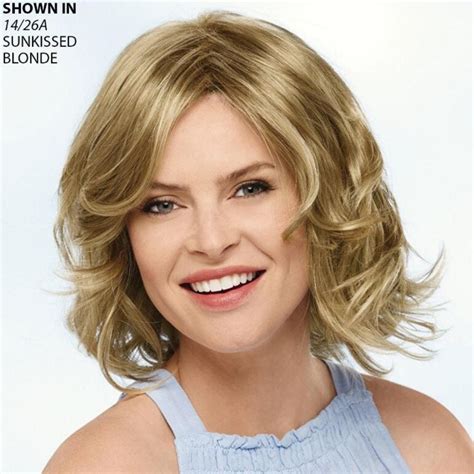In today’s era of boundless beauty options, synthetic wigs have emerged as a formidable contender, offering an array of benefits that challenge the supremacy of human hair extensions. With advancements in fiber technology and innovative techniques, synthetic wigs now rival the look, feel, and style versatility of natural hair.

Why Synthetic Wigs Matter
Synthetic wigs have gained immense popularity for several compelling reasons:
- Affordability: They are significantly more affordable than human hair wigs, making them accessible to a wider audience.
- Durability: Synthetic fibers are resilient and resistant to heat styling, ensuring longevity and ease of maintenance.
- Variety: Available in a vast spectrum of colors, textures, and styles, synthetic wigs cater to diverse aesthetic preferences.
- Convenience: They can be washed and styled with ease, saving valuable time and effort.
- Ethics: Synthetic wigs do not involve the exploitation of animals, aligning with ethical considerations for beauty enthusiasts.
Benefits of Synthetic Wigs
The advantages of synthetic wigs extend far beyond their cost-effectiveness and durability. They offer a plethora of benefits that enhance personal style and confidence:
- Versatile Styling: Synthetic wigs can be curled, straightened, and colored using low heat settings, allowing for endless styling possibilities.
- Natural Look and Feel: Advanced fibers mimic the texture and sheen of human hair, creating a realistic and seamless appearance.
- Low Maintenance: They require minimal care, making them ideal for individuals with busy lifestyles or who prefer low-maintenance hair solutions.
- Color Vibrancy: Synthetic wigs retain their color vibrancy longer than human hair wigs, reducing the need for frequent touch-ups.
- Hypoallergenic: They are often made from materials that are hypoallergenic, reducing the risk of skin irritation for sensitive individuals.
Common Mistakes to Avoid
While synthetic wigs offer numerous advantages, there are common mistakes to avoid to ensure optimal results:
- Excessive Heat Styling: Avoid using high heat settings, as this can damage the fibers and shorten the wig’s lifespan.
- Over-Washing: Excessive washing can strip away the natural oils that give synthetic wigs their shine and luster.
- Improper Storage: Store synthetic wigs in a cool, dry place to prevent tangling and damage.
- Neglecting Regular Maintenance: Regular brushing and detangling are essential to keep synthetic wigs looking their best.
- Using Low-Quality Products: Invest in high-quality wig products, such as shampoos, conditioners, and styling tools, to preserve the wig’s integrity.
Types of Synthetic Wigs
Synthetic wigs come in a wide range of materials and constructions, each with its own unique characteristics:
- Kanekalon: This Japanese fiber is known for its soft, silky texture and natural appearance.
- Toyokalon: A higher-quality fiber that offers exceptional resistance to heat and tangling.
- Modacrylic: A flame-resistant fiber that is often used in wigs for theatrical productions.
- Nylon: A lightweight and durable fiber that is commonly used in budget-friendly wigs.
- Human Hair Blends: Synthetic wigs that combine human hair with synthetic fibers for a more realistic look.
Table 1: Comparison of Synthetic Wig Materials
| Material | Key Characteristics |
|—|—|—|
| Kanekalon | Soft, silky texture, natural appearance |
| Toyokalon | Exceptional heat and tangle resistance |
| Modacrylic | Flame-resistant, suitable for theatrical use |
| Nylon | Lightweight, durable, budget-friendly |
| Human Hair Blends | Realistic look, combines human hair with synthetic fibers |
Table 2: Cap Types for Synthetic Wigs
| Cap Type | Description |
|—|—|—|
| Lace Front | Creates the illusion of a natural hairline |
| Monofilament | Thin and breathable, simulates the scalp |
| Hand-Tied | Individually tied hairs for maximum comfort |
| Weft | Machine-sewn strips of hair, provides volume |
| Capless | Lightweight and breathable, most affordable |
Table 3: Styling Tips for Synthetic Wigs
| Styling Technique | Recommended Tools |
|—|—|—|
| Curling | Ceramic curling iron with low heat settings |
| Straightening | Heat-resistant straightening brush |
| Coloring | Synthetic wig-specific hair dye |
| Detangling | Wide-tooth comb or tangle brush |
| Adding Volume | Teasing brush, root lifter |
Table 4: Maintenance Routine for Synthetic Wigs
| Frequency | Task |
|—|—|—|
| Daily | Brush and detangle |
| Weekly | Wash with wig-specific shampoo and conditioner |
| Monthly | Deep condition with a nourishing mask |
| As Needed | Trim split ends |
Conclusion
Synthetic wigs have revolutionized the hair industry, offering a myriad of options for individuals seeking affordable, stylish, and low-maintenance hair solutions. With advancements in fiber technology and innovative cap designs, synthetic wigs now rival the look and feel of natural hair. By embracing the benefits of synthetic wigs and avoiding common mistakes, you can enjoy unparalleled quality and natural appeal while unleashing your personal style and confidence.
